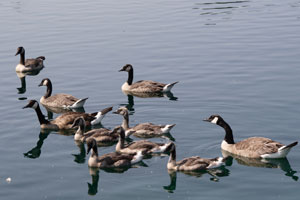If you’ve ever walked or picnicked in areas where Canada Geese congregate, you’ve probably noticed the need to dodge droppings. Canada Geese are a fecal factory. Scientists have actually taken measurements, and found geese go to the bathroom about once every 20 minutes. (Kotrschal et al 1998). Thus, a well fed Canada Geese can produce up to 1.5 pounds of feces a day. Since a flock can number hundreds to tens of thousands of geese, that is a load of goose poop.
 |
Canada Geese (Branta canadensis) are large, with a black head and bill, distinctive white cheek patches, and a black neck that contrasts sharply with their grey body. Canada geese are native to North American. Wikimedia Commons photo. |
Adult geese prefer to land in open farm fields or near water, where there are clear sight lines. This enables them to spot predators more easily. They nest on the ground, typically near bodies of water. Therefore, Canada Geese droppings can pollute the water. Research confirms that large flocks of geese can significantly contribute to degrading water quality.
Some Canada geese migrate to the Artic region each year to breed. Others have stopped migrating. By replacing our native forest with lawns, golf courses and farm fields, especially adjacent to lakes and ponds, we have created opportunities for these non-migrant populations to become established. Instead of an occasional visitor, a subset of Canada geese can become year round residents. Eliminating natural predators has allowed goose numbers to increase.
There are several reasons why non-migratory geese can be considered a nuisance.
- Large amounts of goose feces alongside or in lakes add nutrients like nitrogen and phosphorus that encourage algae and weed growth. In the Quiet Corner, Woodstock’s Roseland Lake has been classified as eutrophic, indicating that nutrients are there in abundance. Geese are believed to be contributing to this problem.
- Canada geese graze and feed on grasses and grains. (Canada geese should NEVER be fed bread or other human food – more on that next week.) A large flock of feeding geese can do significant damage to lawns and recreation fields. Their droppings are acidic and can burn the grass. They can also be a problem on farms fields when they devour seedlings, and graze on fall cover crops that were planted to prevent soil erosion.
- They sometimes congregate in fields, runways and wetlands surrounding airports. Although bird – airplane strikes are rare, they can be extremely dangerous. A big bird like a Canada Goose can fell a plane, especially if it gets sucked into the engine.
- Goose feces are a potential source of human disease. The droppings can contain bacteria and parasites, some of which are not easily controlled using standard water supply chlorination practices. Some of these organisms can cause diarrhea and can potentially become a serious health hazard, especially in people with weakened immune systems.
The Eastern Connecticut Conservation District (ECCD) is currently investigating potential causes of water quality impairments in the Little River/Muddy Brook watershed in Woodstock and Putnam. Several stream sections in this watershed, along with Roseland Lake, are not meeting water quality standards set by the CT Dept. of Environmental Protection. There are several ways you can help with this project.
- If you have photos of Canada geese with goslings, or large flocks of Canada geese in Woodstock in the Muddy Brook/ Little River/Roseland Park watershed, please label and date and send them to Pat Young at ECCD, 238 West Town Street, Norwich, CT 06360, or by email.
- If own property where Canada geese are known to nest, consider allowing trained volunteers on your land to rub corn oil on the eggs (called addling). The oiled eggs will not develop, but adult geese will continue to incubate the eggs. This prevents their numbers from increasing. This process is considered a humane way to control Canada Geese by the Humane Society of the U.S.
- Volunteer to be trained to assist with the pilot egg addling project. Free egg addling training for volunteers will take place at 10 AM on Saturday, March 14, 2009 at the Muddy Brook Fire House on Route 197 in East Woodstock. You do not need to be a Woodstock resident to participate in this training. Pre-registration is required. Call the ECCD at 860-887-4163 x 400.
Part II of this series will feature other best management practices to prevent resident geese from becoming a nuisance in your area. |

